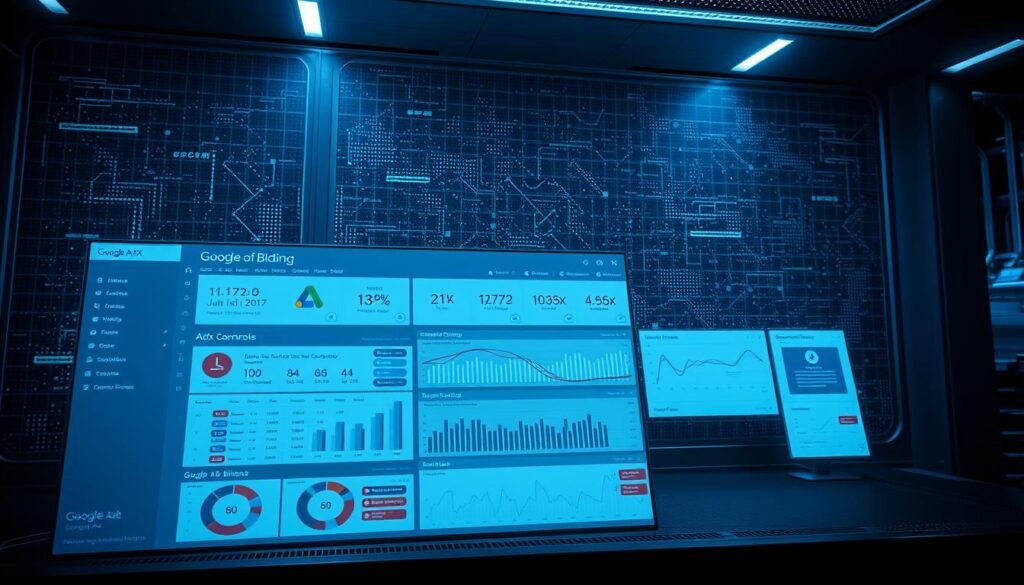On June 27, 2018, two major publishing tools merged into a single platform, shifting how publishers sell impressions at scale.
This change, plus the move to first-price auctions in March 2019, turned milliseconds of bidding into clearer pricing power for sites that manage their own inventory.
In practice, real-time bidding means your pages request ads, buyers race to bid, and the top bid wins under a first-price model. That process links your website to premium demand while you keep control over quality and pricing.
This guide helps U.S. publishers professionalize monetization. You’ll learn how open and private auctions work, when to use preferred deals, and why impression-level CPM selling often outperforms click-only models.
We also cover setup via Google Ad Manager, brand safety, price floors, and layout best practices so you can protect user trust while growing revenue.
What This Ultimate Guide Covers and Who It’s For
For U.S. publishers ready to move beyond basic monetization, this guide delivers practical, step‑by‑step instruction on auctions, controls, and workflows in a modern ad platform.
Who should read this: a publisher with steady traffic aiming to graduate into a data‑driven program. Solo operators and ad ops teams will both find actionable tips and decision checkpoints.
What you’ll learn: how real‑time bidding flows from request to impression, how advertisers submit bids, and how first‑price auctions determine winners. We also cover setting floors, brand safety, blocking tools, and inventory structure to protect the user journey while lifting revenue.

Tools you’ll use in your google manager account include line items, pricing rules, creative review, and reporting metrics. We also explain when to work with certified partners or use MCM resellers so smaller publishers can access premium demand without losing control.
| Reader Type | Key Tools | Expected Outcome |
|---|---|---|
| Solo publisher | Line items, pricing rules | Stronger yield, manageable operations |
| Small team | Creative review, targeting controls | Better user experience, higher CPMs |
| Enterprise / Ad ops | Reporting metrics, advanced management | Scalable revenue and auditability |
| Publishers using partners | MCM access, certified partner services | Access to demand without heavy infra |
Google Ad Exchange within Google Ad Manager: Foundations You Must Know
DoubleClick’s DART and later DoubleClick for Publishers laid the groundwork for today’s manager platform. In 2018, those tools merged into a single system that embeds an exchange capability for impression‑level programmatic trading. This shift moved publishers from bulk selling to per‑impression competition.
From DoubleClick to AdX to Google Ad Manager
DoubleClick publishers evolved from serving servers to running a unified manager. That change made the exchange a built‑in path for premium demand. Publishers kept trafficking controls, line items, and reporting inside one console.
First-price auctions and why they changed the game
With first‑price auctions the winner pays their bid. That makes floor strategy and bid density far more impactful.
Publishers now tune floors by device, GEO, and unit to protect value and lift clearing prices.

AdX vs. ad networks: impression-level selling and transparency
Exchanges sell impressions with granular signals and clear bidding data. Networks often package inventory and resell it, which hides buyer-level detail and reduces transparency.
Using the manager layer, you can let the exchange compete with networks while preserving coverage and control. Technology like latency management and creative scanning keeps delivery fast and safe.
| Feature | Exchange behavior | Network behavior |
|---|---|---|
| Pricing | Per‑impression bids, first‑price clearing | Bulk rates, bundled deals |
| Transparency | Bidder and price visibility, detailed reporting | Limited buyer data, opaque reselling |
| Control | Floors, blocks, device/GEO targeting | Fewer granular controls |
| Role in stack | Drives dynamic competition and yield | Fills coverage and niche demand |
How Real-Time Bidding Works on the Platform
A single page call triggers a rapid workflow where demand sources compete to fill an impression. This split-second process moves from request to render in a strict time budget.
Ad request to impression: the split-second auction flow
Your page calls the server and sends signals about inventory and user context. Eligible buyers receive that call, return a bid, and the highest compliant bid wins under a first-price model.
Keep tags lean and use caching so more bidders can submit offers within the allotted time. Lower latency means stronger competition and better clearing prices.
Open auction, private auction, and preferred deals explained
Open auction invites broad competition and usually drives higher bid density for general inventory. Private auctions let invited buyers compete above a set floor for curated placements.
Preferred deals give select advertisers first look at inventory at a fixed CPM before any auction. Use each path to balance reach, control, and guaranteed revenue.
Decisioning, ad quality, and rendering across devices
Decisioning checks eligibility, policies, and creative quality alongside price. Approved creatives must render cleanly on mobile and desktop so the user experience stays intact.
Responsive formats and simple creatives reduce render failures and protect session metrics.

| Auction Type | When to Use | Primary Benefit |
|---|---|---|
| Open auction | Broad inventory and high demand | Maximizes bid competition |
| Private auction | Curated buyers, higher floors | Control and premium CPMs |
| Preferred deals | Direct fixed-CPM buys | Priority access and stable revenue |
Reporting signals: CPM, viewability, and invalid traffic safeguards
Track impressions, eCPM, viewability, and revenue to link layout and refresh logic to yield. Automated filters remove suspicious activity so advertisers trust reported inventory quality.
Test floor rules, refresh triggers, and targeting to lift session revenue. The right mix of services and auction types increases competition per request and improves CPMs without cluttering the page.
Eligibility, Access Paths, and Accounts
Access to the premium programmatic layer requires scale and account hygiene. Publishers must show steady traffic, clean policy history, and a transparent ads.txt before an invite appears.
Invite-only access via google manager
The invite route runs through your google manager account and hinges on months of consistent metrics. Aim for roughly 5 million pageviews per month and about 10 million impressions over six months as a practical target.
Keep policy violations low, maintain strong viewability, and update ads.txt to strengthen your account profile.
Working with adx partners and the MCM program
If direct invites lag, many publishers partner with an MCM reseller or adx partners. These firms can onboard you faster and handle daily ops.
Expect a revenue share; typical reseller fees range from 15% to 20% of exchange revenue per month in return for tech and optimization support.
Certified publishing partner advantages
Certified publishing partner (GCPP) firms are vetted and offer advanced tooling and ad ops. They speed time to scale and help you gain access google while you build internal capacity.
Once approved, manage your google adx account inside the manager, set line items, and keep testing. Access is a starting point — ongoing tuning drives results.
| Path | Typical Requirements | Primary Benefit |
|---|---|---|
| Direct invite via google manager | 5M pageviews/month; 10M impressions over 6 months; ads.txt; clean policy record | Full control and higher net revenue |
| MCM / reseller | Open to smaller publishers; partner due diligence | Faster access, hands‑off ops for a 15–20% fee |
| Certified publishing partner | Vetted partner status; proven track record | Advanced tech, dedicated ad ops, faster scale |
Setting Up and Managing Your Ad Stack
A clear inventory map and tidy tags cut errors and let demand compete smoothly on every page.
Core setup: tags, line items, price floors, and brand safety controls
Start by defining ad units in the manager and creating line items with granular targeting. Map inventory so reporting, filtering, and pacing match real placements.
Apply price floors by unit, GEO, and device. Use dynamic floors to reduce bid shading and recover lost revenue from stale rules.
Enforce brand safety with category blocks, content labels, and sensitive-topic filters to keep advertisers confident and users comfortable.
Team and tooling: ad ops, QA, A/B testing, and AI-assisted pricing
Build a workflow that includes scheduled QA passes, A/B experiments, and documented changes so outcomes tie to actions.
Leverage technology and AI-assisted pricing to update floors frequently. Coordinate with advertisers and networks through deal types to balance direct and programmatic coverage.
| Focus | Action | Outcome |
|---|---|---|
| Tagging & trafficking | Define units; map inventory in the platform | Cleaner reporting and control |
| Pricing | Dynamic floors by device/GEO | Less bid shading; higher CPMs |
| Operations | QA, A/B tests, weekly reviews | Faster optimization and safer ads |
Optimization Strategies to Maximize Ad Revenue
Small tuning steps—better wrappers, dynamic floors, and viewable formats—unlock outsized revenue. Focus on competition first, then protect the user experience while you iterate.
Header bidding and parallel competition
Deploy header bidding across top SSPs and platforms so more buyers compete before the google exchange runs. Parallel auctions often lift clearing prices and can boost yield by 30%+ when implemented correctly.
Dynamic floor pricing to counter bid shading
Update floors frequently—hourly when possible—using performance signals. Dynamic floors recover revenue that static rules lose and reduce the impact of bid shading without killing demand.
Adaptive formats, Smart Refresh, and viewability-first layouts
Test larger, responsive units that increase in-view time. Use Smart Refresh tied to user actions so ads rotate without interrupting reading.
Prioritize viewability in layout choices to raise session-level yield and higher revenue per placement.
Targeting, blocking, and balancing user experience
Tune contextual targeting and block low-quality categories. Let relevant buyers compete to protect long-term trust and yield for publishers.
Partner with experienced adx partners when they bring AI bidder optimization, adblock recovery, and consent tooling that speeds gains.
| Action | Benefit | Priority |
|---|---|---|
| Header bidding | More buyers, higher clearing prices | High |
| Dynamic floors | Protects CPMs, reduces bid shading | High |
| Smart Refresh | Higher revenue per session | Medium |
| Targeting & blocking | Preserves user experience | High |
Measure RPM, viewable CPM, and session yield—not just fill rate. Keep a changelog and roll experiments by GEO, device, and unit so you can attribute real lifts to specific solutions.
Google Ad Exchange vs. AdSense: Which Fits Your Business
Revenue, control, and operational lift differ widely between full-featured programmatic platforms and plug‑and‑play networks.
Tier 1 markets often see the biggest gains with a dedicated programmatic layer. In many cases, publishers in those GEOs report 20–50% higher revenue when they run an exchange channel versus basic networks.
By contrast, smaller Tier 3 regions can favor google adsense. Lower demand density and regional buyer pools sometimes make the simpler solution more profitable for sites with limited traffic.
Control, transparency, and operational complexity
The programmatic platform delivers impression-level CPMs, granular blocking, and deeper reports. That gives a publisher fine control over pricing, formats, and buyer access.
The trade-off is ongoing ops: floor tuning, testing, and partner management. If you lack an in-house ad ops team, consider a certified partner to run the platform or start with google adsense to keep things simple.
| Factor | Programmatic platform | google adsense |
|---|---|---|
| Expected revenue | Higher in Tier 1; +20–50% | Often better in Tier 3; plug‑and‑play |
| Operational lift | High — testing and floors | Low — minimal daily work |
| Control & transparency | Impression-level reporting, granular blocks | Aggregated demand, less granularity |
When to choose each: pick the programmatic route if you have scale, brand-safe content, and a desire for higher revenue and control. Choose google adsense if you want easy setup and minimal ops. A common path is to pilot a portion of traffic through the programmatic stack while keeping adsense active to compare net results before full migration.
Conclusion
Well‑structured operations and steady experiments are the real engine behind long‑term monetization gains. The manager layer gives publishers impression‑level competition, controls, and reporting to lift yield sustainably.
Start with an eligibility audit, baseline floors, and brand‑safe rules. Test header bidding and adaptive formats, then scale what improves impressions and session RPM.
If you lack internal ops, consider certified publishing partners or MCM resellers, but weigh the common 15–20% revenue share against the partner’s documented lift and support scope.
Keep QA, clean traffic, and regular reviews. Whether you gain access directly or via a partner, steady iteration and clear goals produce measurable results over time.
